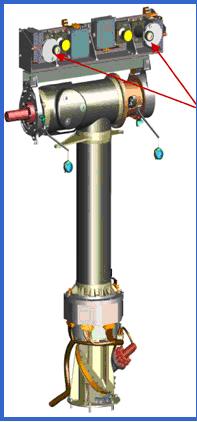sensors
It is estimated that there will be a delay of 3-5 seconds while the rover is on the moon. This delay means that the rover will have to be partially autonomous in order to prevent collisions. In our approach, called safeguarded teleoperation, the user specifies high-level goals such as desired direction of travel, and the vehicle autonomously decides how to execute the command in a way that optimizes a performance criterion. The main obstacle sensor will be forward viewing navigation cameras which detect the obstacles. The image from the cameras will be sent to the central controller and processed to determine if there is a obstacle in Vanguard's path.
The mission objective of being able to send the 'Mooncast' requires a separate set of cameras called the Pancam. The Pancam is used to capture 3600 panoramic view of the moon as well as a high definition video. The Pancam is a high-resolution stereo camera that takes 3600 panoramic color pictures of the surrounding. It was also used on the Mars Exploration Rovers (MER) to capture 3600 panoramic views of the Martian landscape.
Fig. Pancam and Lens
The cameras are located on a "camera bar" that sits on top of the mast of the rover. The Pancam Mast Assembly (PMA) allows the cameras to rotate a full 360° to obtain a panoramic view of the Lunar landscape. The camera bar itself can swing up or down through 180° of elevation. This assembly aloows the Vanguard to take a self portrait.
Thus, the mission objectives of capturing a 3600 panoramic view, a high definition video and a self portrait is accomplished. The data is sent in packets called the 'Mooncast'.


The Pancam cameras are small enough to fit in the palm of your hand (270 grams or about 9 ounces), but can generate panoramic image mosaics as large as 4,000 pixels high and 24,000 pixels around. Pancam detectors are CCDs (charge coupled devices). These devices form the image, just as film does in a film camera.
Pancam Technical Specs
270 g each |
1024x2048 pixel Mitel CCDs |
3 W power for CCD, electronics |
1024x1024 pixel Active Area |
3.5 W power for a small warmup heater |
Field of view: 16.8° x 16.8° per eye |
"Visor" that swings cameras in elevation |
Field of regard: 360° az., ±90° el |
Operating temperature range: -55°C to 0°C |
resolution 0.28 mrad/pixel |
Survival temperature range: -110°C to +50°C |
Focal length 38 mm, f/20 optics |